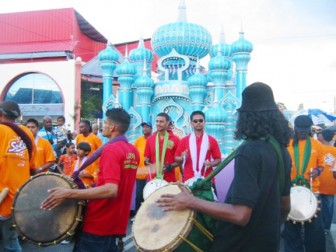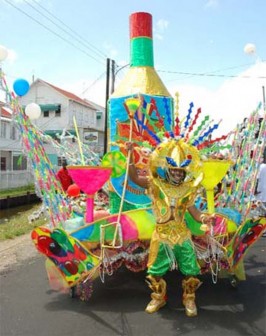There is a great irony in Guyana in the way one of its greatest unifying forces has been characterized as a force of division. A real cultural strength possessed by the nation has been a factor in the rancour. Guyana prides itself in noble words on being a multi-ethnic, multi-cultural nation of “six races,” but this verbally expressed pride has not always been reflected in attitudes and behaviour. Racial and cultural differences are an asset contributing to the wealth of the nation in terms of identity, character, tradition, heritage and art. But the country has been plagued by ethnic issues.
Prejudice is unnatural. It is based on ignorance which immediately leads to intolerance because members of one race know too little about the other race. But cultural differences not only gloriously exist, but exhibit amazing similarities between the deep-rooted ethos of one race and that of another. This may be strikingly illustrated in the case of Guyana.
Take the ancient, brooding, commanding and mysterious-looking silk cotton tree, for example. Different ethnic cultures in Guyana relate to it. This tree is the subject of Amerindian myths and it holds mystic and spiritual significance for Africans and East Indians alike, just as it appears in legends about the former Dutch colonists. For many it is the dwelling place of spirits, ancient energy and the source of creation. There are historical accounts of the importance of silk cotton trees to the enslaved Africans. Yet the same tree appears in the creation myths of other peoples.


Persons in Guyana have used racial diversity as a source of conflict and division. A few years ago letters were written to the editor complaining that Mashramani was inappropriate as a national festival because it was African and only highlighted African culture. Mashra-mani does involve some African elements including performance traditions like the calypso, the steel band, the masquerade tradition and the concept of tramping on the road. Apart from the Chutney Monarch there is hardly any highly visible Indian practice prominent in it, but the notion that it is “African” and inappropriate arises from lack of awareness of the nature of the traditions within the festival and their native ethnic characteristics. It might not be known that there is strong similarity between African and Indian practices embodied in Mashramani.

The main form adopted by Mashramani is that of the carnivalesque. This is the structure of street theatre involving a spectacular theatrical procession along the street incorporating the masquerade tradition and other performances. This tradition includes the parade of masques – designed creative costumes dramatising a theme or a symbolic representation of some story, statement or message. These are worn by masqueraders – performers or dancers who also carry floats and effigies representing messages or themes. These are the costumed bands, accompanied by music, mainly soca that drive the “tramping.” The crowning of monarchs, calypso and steel band also feature prominently.
As already mentioned, it is true that most of these belong to carnival type revelry and shape that may be traced to the masquerade tradition derived from Africa. But this carnivalesque tradition bears very close resemblance to cultural forms brought into the Caribbean from India during indentureship. The first of these is the chutney, a folk-based music evolved from Bhoj Puri, which does not only have evolutionary characteristics parallel to the calypso, but is also used alongside soca as ‘tramping‘ music.
But the most striking factor of ethnic similarity is the street theatre itself. Spectacle is an important characteristic that helps to make it almost identical to Indian forms. The Hindu festival of lights, Diwali, is celebrated by a grand street parade in Guyana in which there are masques, performers, creatively designed costumes representing the Hindu pantheon and symbols, dancers and masqueraders representing Mother Laxhmie to whom the Diwali festival is devoted.
As it happens, there are African masquerade traditions in which masked dancers appear in bands on the street, dressed in creatively designed costumes representing gods and ancestral spirits to whom the festival is devoted. Just as tassa and other drums are used in Diwali, different drums are used in the African parades. To take the similarities even further, in the Indian drumming traditions in Guyana, the tabla is played for religious music and there are special ‘hands‘ played by drummers specifically for certain gods and deities. In African drumming there are special rhythms played that are recognisably identified with certain gods and ancestral spirits.
These parallels and similarities go deep. African drumming traditions include rhythms which are made up of a combination of drums playing in unison. A common combination is the use of a bass drum along with a main rhythm drum and a cutter or high-pitched cutting drum which improvises in counterpoint to the bass and rhythm. In Indian tassa drumming there is a ‘boom’ or bass drum along with a middle drum holding the rhythm and the very high-toned lead drum that carries the characteristic tassa roll.
One of the high points in Mashramani, as it is in the Trinidad carnival, is the crafting of costumes that were used to contribute to a competitive ‘band of the year‘ contest in the past. The skill of costume design and manufacture is highly regarded among black and coloured participants. But what makes them seriously different from Indians in Guyana and Trinidad? Another religious tradition performed by Indians is the Hosay, which is an Islamic festival. Accompanied by drums, participants parade along the streets with towering effigies, elaborately designed symbolic floats and tadjas. The European colonials were quite hostile to these parades in the nineteenth and early twentieth centuries, yet the Trinidad newspapers of those times carry high praise for “the skill and creativity“ displayed in the making of the colourful, spectacular costumes and floats.
So, then, just how ‘African‘ is Mashramani?
People might be hostile to each other based on ethnic differences, but not cultures. A close examination of the wedding traditions of Hindus and Africans will reveal similar beliefs, customs and practices that one could well believe it was one culture. At another time it would be amazingly revealing to analyse the kwe kwe (queh queh) rituals and customs of African Guyanese alongside the Matikoor or Dig Dutty pre-nuptial performances of East Indian Guyanese.
One has to ask, what is the hostility about? Where are the differences?




